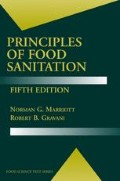Summary
Hazard Analysis Critical Control Points is a state-of-the-art preventive approach to safe food production. This concept is based on the application of prevention and documentation. HACCP is a proactive prevention program based on sound science. The essential steps for HACCP plan development are: assembly of an HACCP team; description of the food and its intended use; identification of the consumers of the food; development and verification of a process flow diagram; conduction of a hazard analysis; identification of critical control points; and establishment of critical limits, monitoring requirements, corrective actions for deviations, procedures for verification, and record-keeping procedures.
Good manufacturing practices are considered the building blocks of HACCP, and sanitation operating procedures are the cornerstones for an HACCP plan. Documentation needed for an effective plan includes descriptions of HACCP team-assigned responsibilities, product description and intended use, flow diagram with identified CCPs, details of significant hazards with information concerning preventive measures, critical limits, monitoring to be conducted, corrective action plans in place for deviations from critical limits, procedures for verification of the plan, and record-keeping procedures. Periodic auditing is necessary for validation and to provide a report card for the program.
Access this chapter
Tax calculation will be finalised at checkout
Purchases are for personal use only
Preview
Unable to display preview. Download preview PDF.
References
Anon. 2004. Plants have spent plenty on HACCP, ag department finds. Meat Market Technol August:: 10.
Bauman, H.E. 1987. The hazard analysis critical control point concept. In Food protectiontechnol, ed. C.W. Felix, 175. Chelsea, MI: Lewis Publishers.
Chen, T.C., and Wang, P.-L.T. 2003. Poultry processing, product sanitation, and HACCP. In Food plant sanitation, 515. New York: Marcel Dekker, Inc.
Clark, D. 1991. FSIS studies detection of food safety hazards. FSIS Food Saf Rev 4: Summer.
Marriott, N.G., et al. 1991. Quality assurance manual for the food industry. Virginia Cooperative Extension, Virginia Polytechnic Institute and State University, Publication No. 458-013.
National Advisory Committee on Microbiological Criteria for Foods. 1997. Hazard analysis and critical control point principles and application guidelines.
Pierson, M.D., and D.A. Corlett Jr. 1992. HACCP principles and applications. New York: Van Nostrand Reinhold.
Shapton, D.A., and N.F. Shapton, eds. 1991. Establishment and implementation of HACCP. Principles and practices for the safe processing of foods, 21. Oxford: Butterworth-Heinemann.
Slade, P.J. 2002. Verification of effective sanitation control strategies. Food Saf Mag 8, no. 1: 24.
Stevenson, K.E., and D.T. Bernard. 1995. HACCP: Establishing hazard analysis critical control point programs—A workshop manual. Washington, DC: National Food Processors Institute.
Rights and permissions
Copyright information
© 2006 Springer Science+Business Media, Inc.
About this chapter
Cite this chapter
(2006). The Role of HACCP in Sanitation. In: Principles of Food Sanitation. Food Science Texts Series. Springer, Boston, MA. https://doi.org/10.1007/0-387-25085-9_7
Download citation
DOI: https://doi.org/10.1007/0-387-25085-9_7
Publisher Name: Springer, Boston, MA
Print ISBN: 978-0-387-25025-0
Online ISBN: 978-0-387-25085-4
eBook Packages: Chemistry and Materials ScienceChemistry and Material Science (R0)

